Giuseppe Rizzo is an art historian with a specialism on the life and works of Clemente Papi. Giuseppe works at the Uffizi Gallery in Florence.
The history of the first copies of Michelangelo’s David are linked to the cast maker Clemente Papi (1803-1875), who, over the course of his career, made three life-size reproductions of the entire statue, two in plaster and one in bronze. But who was Clemente Papi? What led him to make copies of David? And why is he so important to the history of sculpture?
Papi was a plaster cast maker in Florence, who later turned to bronze and was appointed the first Royal Founder in Bronze. He revived the ancient lost-wax technique and created perfect copies of existing works and original pieces. Although his name is little known today, his statues stand in prominent locations in Britain, Europe and the United States.
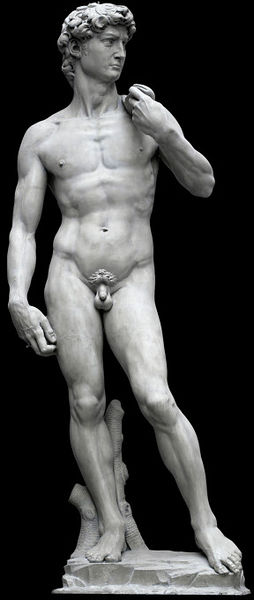
Early life
Clemente Papi was born in Rome in the Trastevere area in 1803. He was the sixth son of Scholastica Hofer and Luigi Papi, a shopkeeper and skilled pyrotechnic. In 1810, due to the French invasion, his father moved to Florence with his family where he undertook various activities, including refining sugar, bleaching raw linen, making glue, verdigrises’ and soap.
At the age of 15, Clemente Papi enrolled in the Academy of Fine Arts. His artistic skills in modelling in plaster were immediately appreciated by his professors, especially the painter Pietro Ermini, the sculptors Francesco Carradori, and Stefano Ricci. Indeed, after his academic education, Papi was active in the sculpture studio of Ricci, located in the Chiostro dello Scalzo, close to the Academy Gallery where the original David is now housed.
Initial copies of Florentine Renaissance statues for overseas
Papi soon received important commissions for the reproduction of Florentine works of art. During the 1830s, he made copies for the French government of Ghiberti’s Gates of Paradise, Donatello’s St. George, several of Michelangelo statues from the New Sacristy in the St. Lawrence church, and many other Florentine plaster casts. These were destined for the new ‘Musée des modèles’ annexed to the Ecole des Beaux Arts in Paris. [see photo]. It was the first pedagogical museum dedicated to Renaissance plaster cast statues and the inspiration for the future V&A, although it didn’t have a copy of David.
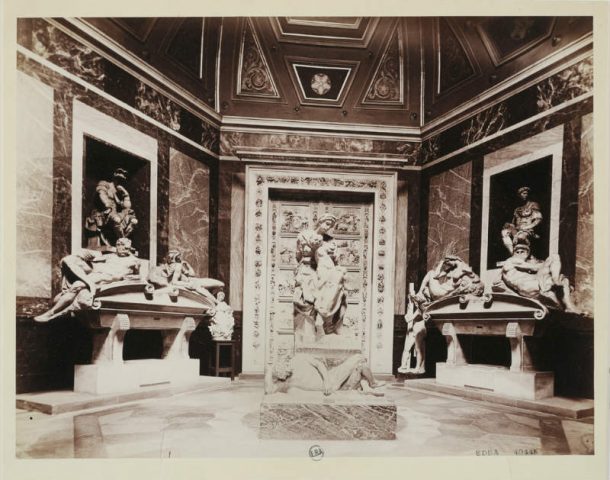
In those same years, Clemente Papi began experimenting with the technique of lost wax casting. In this process a mould is made using wax and this is then melted with hot metal to form the cast. In so doing, he revived the ancient art of largescale sculpture in bronze, which had previously been used in Florence by the great artists of the fifteenth and sixteenth centuries. The technique produces smooth sculptures and perfect copies. Initially Papi operated in a small workshop set up in the Academy of Fine Arts (see link to Giuliana Videtta, Blog 2), but later he established his own workshop at Porta San Gallo close to today’s Piazza della Libertà.
Then in 1839, thanks to prestigious commissions from the 2nd Duke and Duchess of Sutherland, Papi began making other copies. This included a reproduction of the terrifying group of Perseus with the head of the Medusa by Benvenuto Cellini, which was placed in the Gardens of Trentham Hall, Staffordshire, where it is still exhibited. [http://www.trentham.co.uk/]. It was and still is the only copy made directly from the original. He also made a full-size bronze copy of Giambologna’s Venus-Fiorenza.
Shortly before Clemente Papi completed the casting of the great and complicated Perseus statue, the Grand Duke of Tuscany named him ‘Royal Founder of Bronze Statues’ (1843). He became the main founder of Tuscany and after the Unification of the Kingdom of Italy was acclaimed ‘first founder of Italy’.
Major bronze statues
At the service of the Grand Ducal court, Clemente Papi cast many contemporary works in bronze, especially those by his friend the sculptor Giovanni Duprè. Important examples still in existence include Cain and Abel, exhibited in the Modern Art Gallery in Florence [see photo], and the model of the Allegories of the Seasons, present since 1855 in the Sala Castagnoli of Palazzo Pitti (Galleria Palatina, Florence) [see photo].
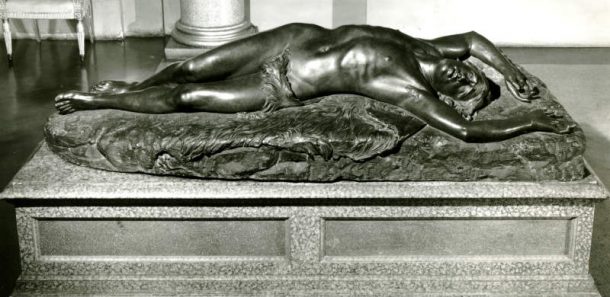
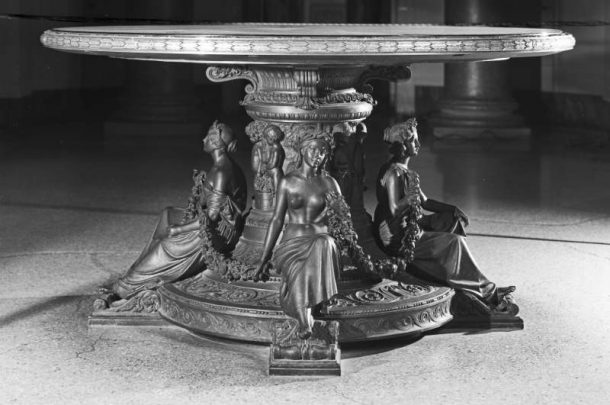
After the creation of the Kingdom of Italy (1859), Clemente Papi was at the service of King Vittorio Emanuele II. Inside his New Royal Foundry, [see photo], Papi created in bronze the main celebratory monuments of the characters who had participated in the unification of Italy. These works were installed in the squares of Florence, Turin and Milan.
Papi also achieved international success, receiving commissions from countries including Peru and Russia, as well as foreign sculptors. One the most famous was George Simond’s Falconier which was placed in New York’s Central Park and is still there today
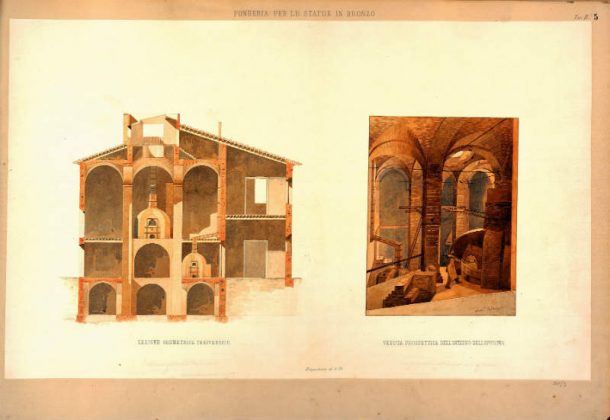
Clemente Papi also dedicated himself to smaller, more personal works of art that attracted wider interest, and cast directly from plants and animals. These works served to make Papi’s rediscovery of the ancient lost-wax technique known to a wide international public, and his production was of particular interest to private clients. His works were displayed in a number of Florentine exhibitions (1850 and 1861), as well as the Universal Exhibitions in London (1851), New York (1853) and Paris (1855). The Russian Prince Anatoly Demidoff was among the collectors most fascinated by his work, and kept a Tripod with flower basket, by Papi in his villa at San Donato. This work was on display at the Great Exhibition in London in 1851, and was repeatedly reviewed in newspapers of the time [see photo].
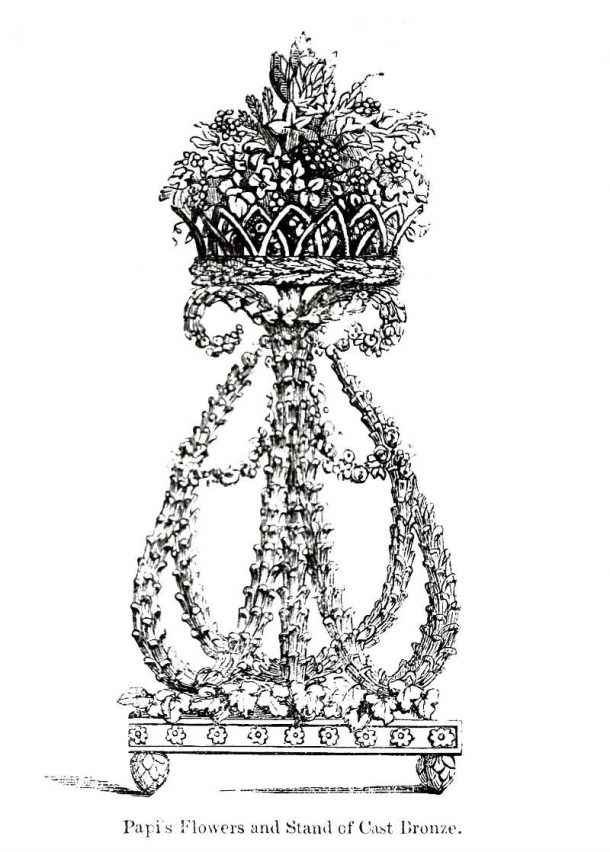
Papi and the three copies of David
However, the most important work for which Clemente Papi is remembered today is undoubtedly the bronze cast of Michelangelo’s David, that stood in the Piazzale Michelangelo in Florence from 1874.
Papi made the mould of the entire statue in 1847, from which he created his first full scale replica in 1853, and a second replica in 1856 for the South Kensington Museum. The colossal bronze cast of the Michelangelo masterpiece, ordered by the Grand Duke of Tuscany in 1846, was made in the New Royal Foundry in 1866. Initially, it received harsh criticism in Florence from a group of Macchiaioli painters and intellectuals. Yet when the bronze statue was inaugurated in September 1875 on the Piazzale Michelangelo, public opinion was very favourable. On that occasion a sonnet written by an anonymous man and temporary applied on the David Monument honored both the Renaissance artist and the Royal Founder Papi. In it we read:
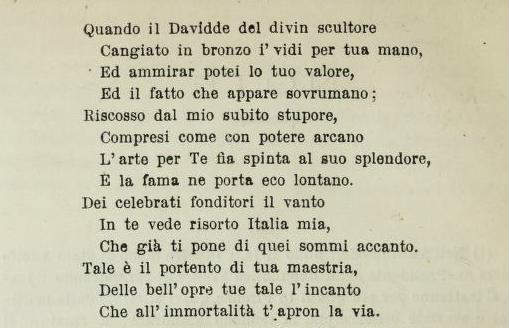
I saw bronze in your hand,
And I admire your value,
And the fact that it appears superhuman;
Shacked from my suddenly amazement,
Penetrated as with arcane power
Art for You is pushed to its splendour,
And fame brings it far echo.
The pride of the famous founders
In you sees the resurrection my Italy,
Which already puts you of those high above.
Such is the portent of your mastery,
Of the beautiful your works such the enchantment
May the way open to immortality.
Death and legacy
Unfortunately Clemente Papi passed away before the statue was unveiled. He was buried in the Cemetery of the Venerable Compagnia della Misericordia in Florence and, in accordance with the regulations in force, no commemorative inscriptions could be placed on his tomb. His friend Antonio Faleni published a short text, The Life of Clemente Papi, in 1875, with the following epigraph that was designed as a tombstone inscription:
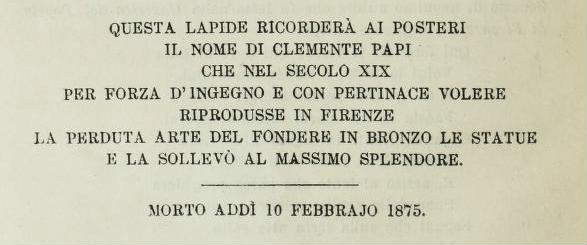
Although Papi’s name may not be so well known today, millions gaze on the statues that he produced- copies and originals- in Florence, Turin, Milan, Central Park and of course, the V&A.
Stay tuned for Giuseppe Rizzo’s next post Part 2 – David’s journey from Florence to V&A
Bibliography
Antonio Faleni, Notizie storiche del David del Piazzale Michelangelo e cenni biografici del Cav. Prof. Clemente Papi, Tipografia della Gazzetta dei Tipografi, Firenze, 1875.
Giuseppe Rizzo, Clemente Papi “Real Fonditore”: Vita e opere di un virtuosistico maestro del bronzo nella Firenze dell’Ottocento, in «Mitteilungen des Kunsthistorischen Institutes in Florenz», 2010-2012, 54, 2, pp. 295-318.
Giuseppe Rizzo, Il “risorgimento” dell’industria fusoria a Firenze: la regia fonderia di statue in bronzo di Clemente Papi prima e dopo l’Unità d’Italia (1837-1875), in «Bollettino della Società di Studi Fiorentini», 20-21 (2011-2012), Alinea, Firenze, 2012, pp. 121-131.



Arts are Incredible
This is really a great stuff for sharing. Keep it up .Thanks for sharing.